Tl; dr;
- Relevance over volume: Prioritize insights that align with strategic goals, not just data quantity. Irrelevant data, no matter how abundant, won't drive effective decisions.
- Survicate's Insights Hub for ready-to-use actionable insights: With this new tool, you jump all the boring parts of data analysis, speeding up strategic decisions about your product.
- Avoid confirmation bias: Actively seek diverse data and challenge assumptions to ensure insights are valid and unbiased, preventing skewed decision-making.

Have you ever felt overwhelmed with incoming data? There’s so much buzz around it’s really hard to keep up with everything. But how much of this data is something actually ready to use?
Yup, there’s a clear difference between the oceans of meaningless information and actionable insights.
Insights make data useful. They convert the "whats" into the "whys" behind to help you make informed decisions.
So, let’s dive into this topic and learn more about actionable insights, the difference between insightful and non-insightful data, and how to turn all that buzz into a strategic business advantage. 🌊
What are actionable insights?
Actionable insights are specific, data-driven findings that offer clarity on complex issues, along with a clear path to an effective response. When you discern an actionable insight, it not only highlights what is happening but also why it’s happening, which equips you with the knowledge to make informed decisions.
Key attributes of actionable insights:
- Relevance: Your insights should be closely aligned with your strategic objectives, ensuring they contribute meaningful value to making your business decisions.
- Accessibility: The findings need to be readily available to decision-makers, presented in a manner that is understandable and actionable.
- Timeliness: Insights should be provided in a timeframe where action can be taken effectively to influence the outcome.
Why are actionable insights important?
⭐ Data-driven decisions
Actionable insights empower you to make better, data-backed decisions regarding customer experience and avoid relying on intuition alone.
⭐ Strategic planning
They help craft and adjust business and product strategy by providing a fact-based foundation for your planning efforts.
⭐ Competitive advantage
By acting on insights, you can maintain a competitive edge through proactive rather than reactive measures.
⭐ Efficiency and productivity
You can streamline operations and allocate resources more effectively with clear insights.
The difference between insightful and non-insightful data
When we dive into data, we're often met with a mountain of numbers and facts. Insightful data stands out because it goes beyond the surface to reveal deeper meaning and patterns that can lead to effective actions.
For example, an e-commerce store might notice a spike in sales every Wednesday; the raw data shows the increase, but the insight comes from understanding why this happens and how to capitalize on it.
On the other hand, non-insightful data is just raw information without context or explanation.
It's like noting that the store had 1,000 visitors on a given day without knowing what drove them there or their behavior on the site. Without the why and the how this data lacks the power to inform decisions.
What are data collection strategies?
Your approach to collecting data is critical to converting data into actionable insights. You can choose between quantitative and qualitative methods, but remember that they should align with your objectives and the type of insights you need.
Quantitative methods
Quantitative research methods can help you generalize findings across larger populations. They involve collecting and analyzing numerical data to identify patterns, relationships, and trends.
Common methods include:
Online surveys: You can create structured surveys with closed-ended questions to collect numerical data that are easily quantifiable.
Product Analytics: It includes tracking metrics like usage patterns, feature engagement, and user behavior to make informed decisions and improve the product’s performance and user experience.
Qualitative research
Qualitative research methods dive deep into nuances. They give you a handful of quotes for further analysis and ultimately to be turned into actionable insights that help close the customer feedback loop.
Usually:
Online surveys: Open-ended questions can collect nuanced feedback, revealing customers' true feelings and experiences, leading to valuable insights for strategic decisions.
User interviews: One-on-one interviews provide deep insights into participant's perspectives. For a more nuanced view, keep interviews semi-structured to allow for probing questions.
Focus groups: Gathering a small group for a discussion can shed light on collective views and is useful for exploring more complex issues.
💡Tip: Ensure to select participants who represent customer personas.
How to get actionable insights from customer feedback?
To derive actionable insights, you need a fit customer feedback collection program.
You can collect feedback with Net Promoter Score (NPS), online reviews, or customer interviews. Each of these options provides a spectrum of data, aiding in comprehensive analysis.
Net Promoter Score (NPS)
NPS surveys are a direct measure of your customer's willingness to recommend your products or services. They ask one simple question: "On a scale of 0-10, how likely are you to recommend our company?" Your customers are categorized as Promoters (9-10), Passives (7-8), or Detractors (0-6).
- Promoters indicate high satisfaction and loyalty.
- Passives are satisfied but unenthusiastic.
- Detractors are unsatisfied and can harm your brand through negative word-of-mouth.
To calculate NPS: NPS = (% of Promoters) - (% of Detractors)
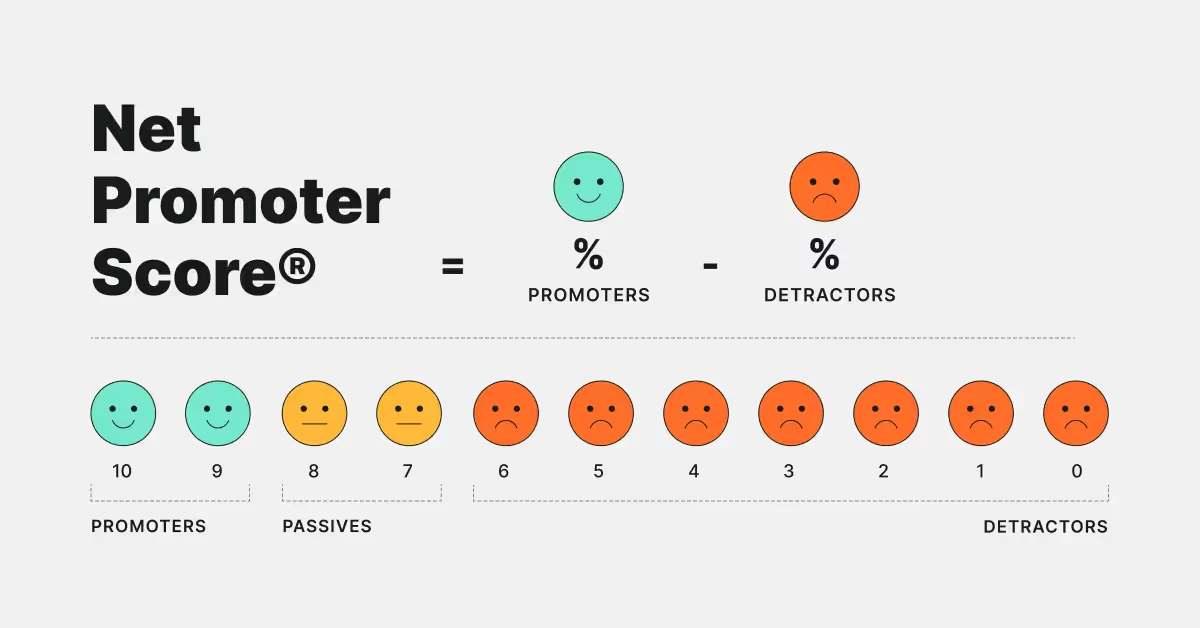
To generate actionable insights faster, you can use Survicate's AI text analysis feature. It will quantify and structure this qualitative data, allowing you to identify trends and recurring themes in customer satisfaction.
Online reviews
Your presence on digital platforms yields an array of customer opinions in the form of online reviews. Valuable feedback comes from:
- Ecommerce platforms
- Social media
- Google My Business pages
- Review platforms
- App store reviews
Customer interviews
Conducting customer interviews provides an in-depth understanding of customer experiences. During these interviews, you should:
- Prepare open-ended questions to elicit comprehensive responses
- Record and transcribe the conversation for accuracy
- Sum up your customer esearch with examples of actionable insights
Remember, direct conversations with customers can reveal nuances in the customer journey that structured data collection methods might miss.
How to derive actionable insights from your data?
Collecting customer feedback is one thing. But it gets you just halfway through the path to actionable insights.
To transform it, you need to analyze the raw data. Now, anyone who has ever analyzed open-text feedback knows just how tedious the job is. Manual tagging, categorizing, and scrolling through endless spreadsheets of feedback aggregated from different sources.
Now, at least, there’s AI that can speed up the process. However, this option may leave GDPR and general security concerns.
Automating the open-text customer feedback analysis
To make the most of your qualitative data, use a customer feedback analytics tool, such as Insights Hub.
After you connect all of your data sources—be it surveys, app store reviews, customer support interactions, or CSV files—the data will be automatically categorized into topics and presented as actionable insights. Importantly, you can create your own categories, which will also be populated with insights from the aggregated feedback.
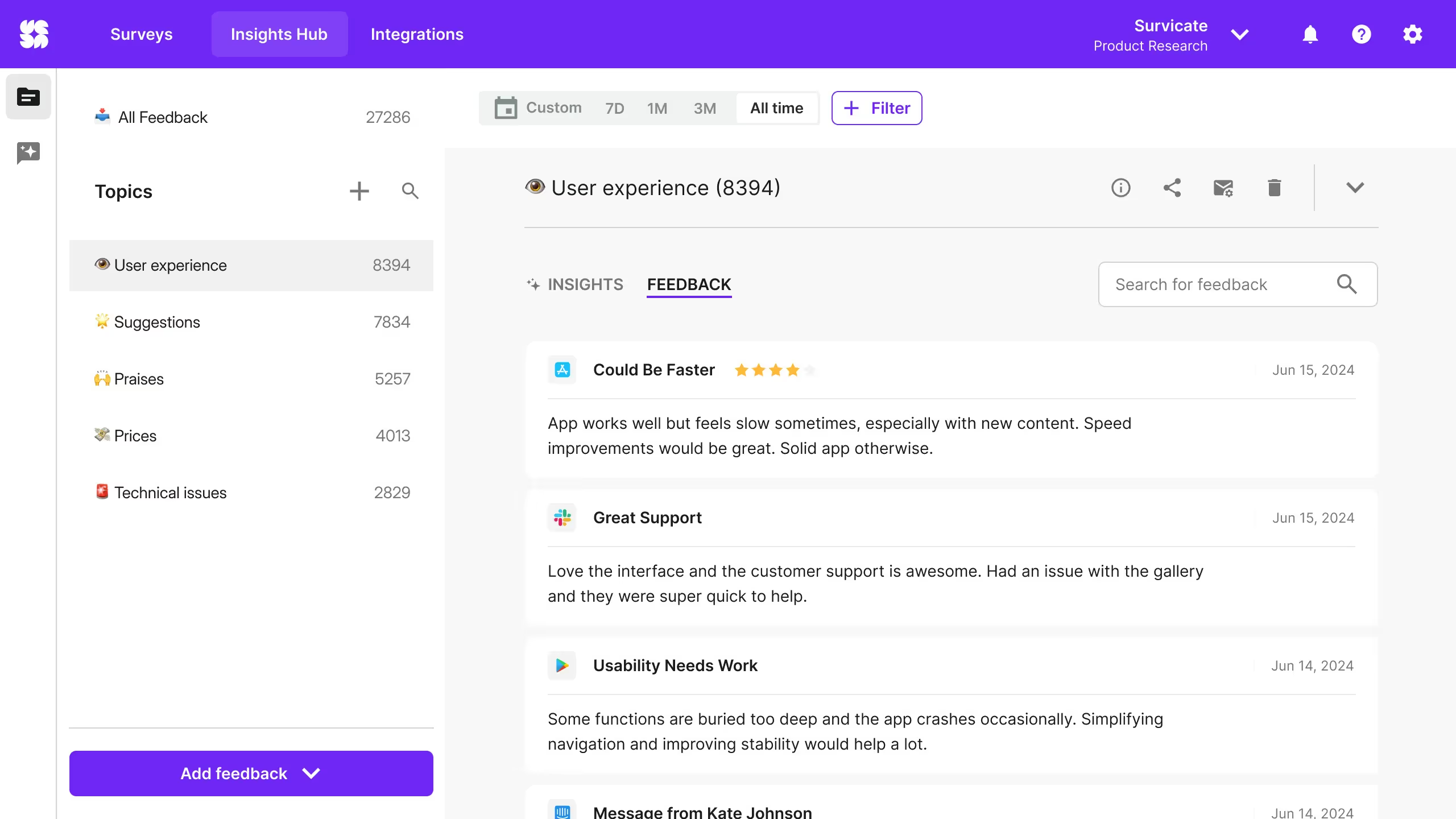
For more detailed queries, you can use the Insights Assistant, a conversational AI tool. You can ask any question related to your feedback data, and instantly receive insights generated upon the data you connected or uploaded. Their sources can be traced with just a click, so you keep full control over the process.
Key features:
- AI feedback categorization and analysis for the following sources: email, App Store, Google Play Store, Intercom, Zendesk, HubSpot, Slack, Zapier, and custom .csv files (more to come).
- Conversational Research Assistant finding actionable insights on topics that particularly interest you
- Actionable insights with fully trackable sources within your customer feedback data.
How to get more actionable insights with feedback management software?
Feedback management software enables you to collect data directly from your target audience. You can conduct customer satisfaction surveys and hypothesis testing to derive insights relevant to your needs.
Advanced platforms often come with built-in analytics to help transform survey responses into meaningful trends and patterns.
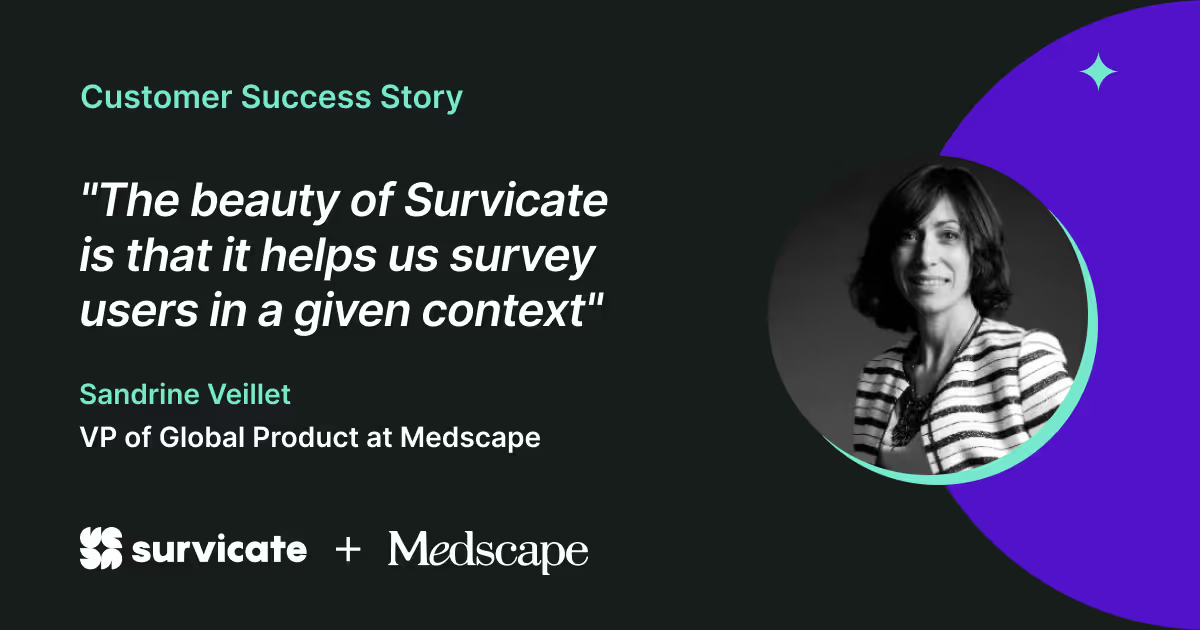
Key features:
- Multichannel survey distribution: email, link, website, in-product, mobile in-app surveys
- Survey advanced targeting
- AI analysis of open-ended survey questions
Common pitfalls in analyzing data
While extracting actionable insights from data, you must navigate common errors that can compromise your analysis. Pay special attention to:
Overlooking context 🔍
Context is king. When you're examining data, it's essential to consider the external factors and situations surrounding the data points. Without it, data can appear misleading. For instance:
- Timeframes: A sales spike might not be a trend but tied to a one-time event.
- Environment: Economic or political factors can skew results outside of normal conditions.
Confirmation bias
Confirmation bias can lead you to favor information confirming your existing beliefs or hypotheses. To avoid this:
- Actively seek out opposing viewpoints and data.
- Use a variety of sources and methods to challenge your initial conclusions.
Misjudging data relevance
Understanding which data is pertinent to your question is a skill to hone. Common mistakes include:
- Ignoring critical variables that could affect your outcome.
- Considering irrelevant information that does not impact your analysis.
To ensure relevance:
- Clearly define your goals.
- Filter out noise that does not contribute meaningfully to your analysis.

Reach actionable insights with Survicate
The journey from data collection to actionable insights may, at times, be tedious, but it's crucial for informed decision-making. Tools like Survicate can make this process more effortless by offering comprehensive customer feedback analytics software and online surveys to complement the research.
These features not only speed up the conversion of customer feedback into strategic insights but also ensure they are relevant, timely, and unbiased.
To experience how Survicate can transform your data into actionable insights and drive your decision-making process forward, sign up to Survicate's 10-day free trial with all of the Best plan features included.








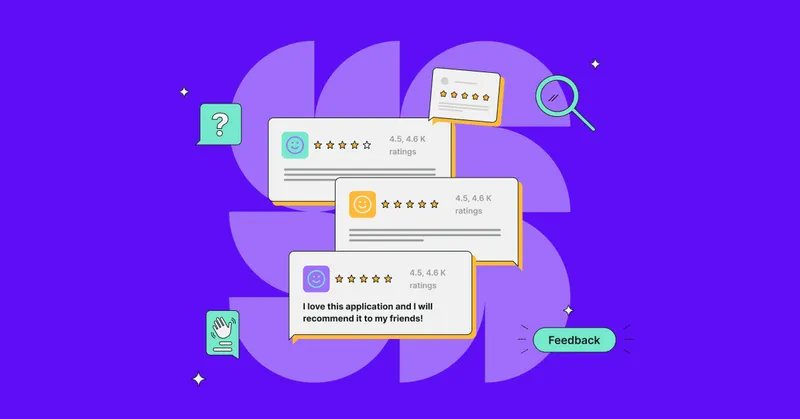
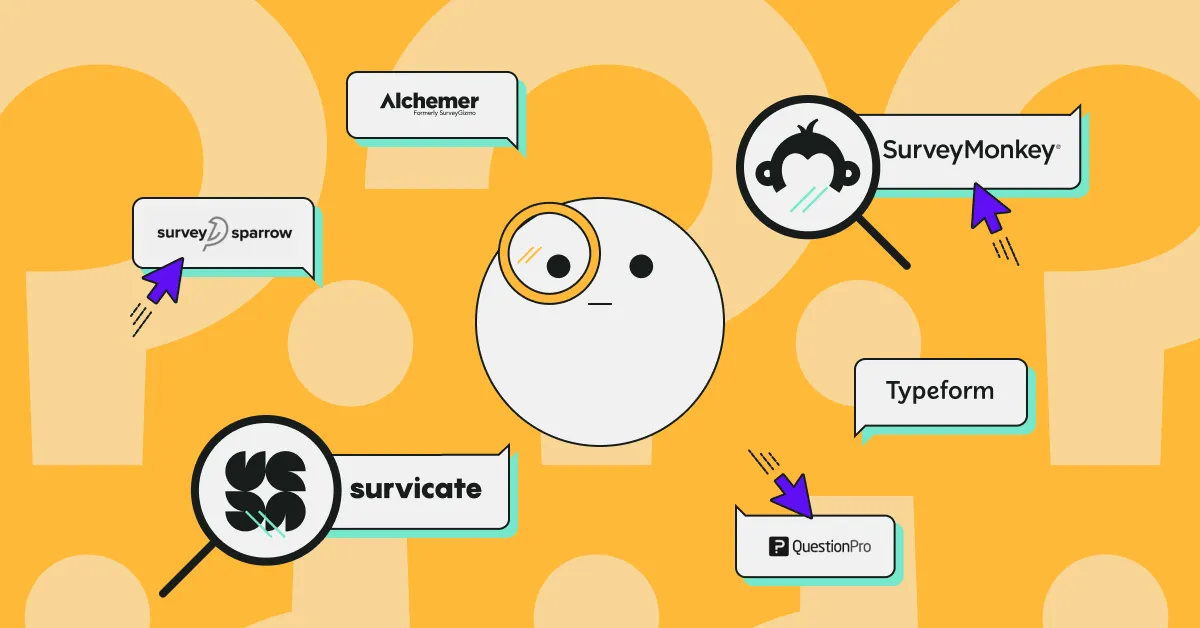
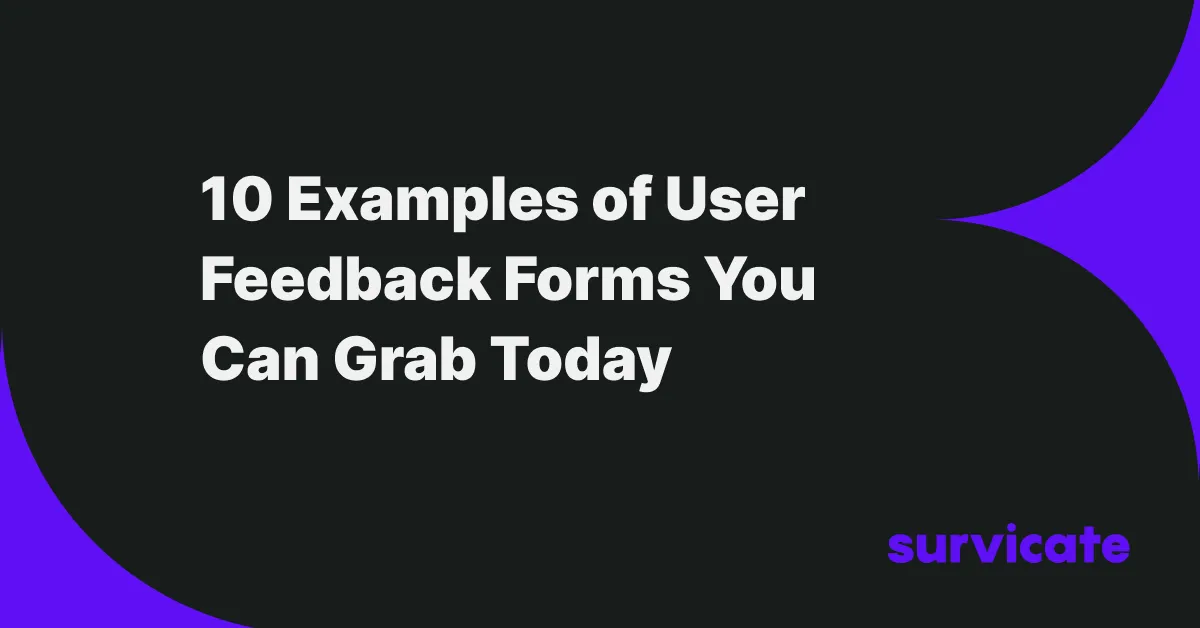
.png)



.svg)

.svg)


